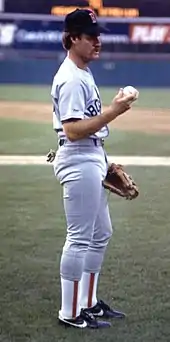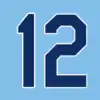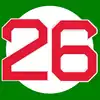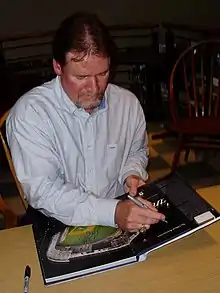Wade Boggs
Wade Anthony Boggs (born June 15, 1958) is an American former professional baseball third baseman. He spent his 18-year baseball career primarily with the Boston Red Sox, but he also played for the New York Yankees, with whom he won the 1996 World Series over the Atlanta Braves, and the Tampa Bay Devil Rays, with whom he reached 3,000 hits. His hitting in the 1980s and 1990s made him a perennial contender for American League batting titles. He is 33rd on the list of career leaders for batting average among Major League Baseball players with a minimum of 1,000 plate appearances, and has the highest ranking of those still alive. Boggs was elected to the Red Sox Hall of Fame in 2004 and the Baseball Hall of Fame in 2005.
| Wade Boggs | |||
|---|---|---|---|
_(cropped).jpg.webp) Boggs in 2013 | |||
| Third baseman | |||
| Born: June 15, 1958 Omaha, Nebraska | |||
| |||
| MLB debut | |||
| April 10, 1982, for the Boston Red Sox | |||
| Last MLB appearance | |||
| August 27, 1999, for the Tampa Bay Devil Rays | |||
| MLB statistics | |||
| Batting average | .328 | ||
| Hits | 3,010 | ||
| Home runs | 118 | ||
| Runs batted in | 1,014 | ||
| Teams | |||
| Career highlights and awards | |||
| |||
| Member of the National | |||
| Induction | 2005 | ||
| Vote | 91.9% (first ballot) | ||
With 12 straight All-Star appearances, Boggs is third only to Brooks Robinson and George Brett in number of consecutive appearances as a third baseman. In 1997, he ranked number 95 on the Sporting News list of the 100 Greatest Baseball Players.[1] Boggs, a 1976 graduate of Plant High School in Tampa, Florida,[2] currently resides in the Tampa Palms neighborhood of Tampa.
Early life
Born in Omaha, Nebraska,[3] the youngest of three sons of Winfield Kennedy Boggs Jr. and Sue Nell Graham, Wade had a regimented military upbringing. Winfield and Sue met in 1946 at a military base in Georgia. Winfield served with the Marines in World War II and flew for the Air Force in the Korean War, while Sue piloted mail planes in World War II.[4][5] The Boggs family lived in several different places (including Puerto Rico and Savannah, Georgia) before settling in Tampa, Florida when Wade was 11 years old.[4][5] He attended Plant High School in Tampa, where he played baseball and was an All-State football player as a senior. Boggs played quarterback until his senior year when he switched positions to avoid injury and thereby protect his baseball career. His success as a left-footed placekicker and punter earned him a scholarship offer from the University of South Carolina.[4] He graduated from Plant High School in 1976 and was selected by the Boston Red Sox in the seventh round of the 1976 MLB draft on the advice of veteran scout George Digby. He signed with the club for $7,500.[4]
Minor league career
Boggs played in the longest game in professional baseball history as a member of the Pawtucket Red Sox in 1981 against Cal Ripken, Jr. and the Rochester Red Wings. It lasted for 33 innings over eight hours and 25 minutes. The game took place from April 18–19, 1981, at McCoy Stadium in Pawtucket, Rhode Island."[6] During his last year in the minor leagues with Pawtucket, he led the league with a .335 batting-average, 167 hits, and 41 doubles.[7]
Major league career
Boston Red Sox
A left-handed hitter, Boggs won five batting titles starting in 1983. He also batted .349 in his rookie year, which would have won the batting title, but he was 121 plate appearances short of the required minimum of 502. From 1982 to 1988, Boggs hit below .349 only once, hitting .325 in 1984. From 1983 to 1989, Boggs rattled off seven consecutive seasons in which he collected 200 or more hits, an American League record for consecutive 200-hit seasons that was later matched and surpassed by Seattle's Ichiro Suzuki. Boggs also had six seasons with 200 or more hits, 100+ runs, and 40+ doubles. Although he would not win another batting title after 1988 (his batting title that year broke Bill Madlock's Major League record of four by a third baseman), he regularly appeared among the league leaders in hitting.

In 1985, Boggs had 72 multi-hit games, a club record.
In 1986, Boggs made it to the World Series with the Red Sox, but they lost to the New York Mets in seven games. He holds the record for batting average at Fenway Park, at .369.
Boggs had a power surge in 1987, setting career-highs with 24 home runs, 89 RBIs, and a .588 slugging percentage. He never hit half as many home runs in any other season.
New York Yankees
In 1992, Boggs slumped to .259—one of only three times in his career that he failed to reach .300—and at the end of the season, he left the Red Sox, with whom he had spent his entire career to that point. He was heavily pursued by two teams: the Los Angeles Dodgers and the arch-rival of the Red Sox, the New York Yankees. He chose the Yankees when they added the third year to the contract that the Dodgers would not offer. Boggs went on to be awarded three straight All-Star appearances, had four straight .300-plus seasons, and even collected two Gold Glove Awards for his defense.
In 1996, Boggs helped the Yankees win their first World Series title in 18 years, which became his only world title. In the series' fourth game, which saw the Yankees rally from six runs down to win, Boggs was called on to pinch hit in the tenth inning and using the batting eye he was known for throughout his career, he coaxed a bases-loaded walk out of Steve Avery, which gave the Yankees the lead in a game they went on to win 8–6.[8] After the Yankees won the series in game 6, Boggs memorably celebrated by jumping on the back of an NYPD horse, touring the field with his index finger in the air, despite his self-professed fear of horses.[9][10]
Tampa Bay Devil Rays
Boggs signed with the Tampa Bay Devil Rays for the final two seasons of his career. He hit the first home run in Devil Rays history in the 6th inning of the inaugural game on March 31, 1998. On August 7, 1999, he collected his 3,000th hit with a home run. Despite his reputation for lacking home-run power, he is one of only three players whose 3,000th hit was a home run; he was the first to make such a hit a home run.[11] followed by Derek Jeter on July 9, 2011, and Alex Rodriguez on June 19, 2015. Boggs retired in 1999 after sustaining a knee injury, leaving with a career batting average of .328 and 3,010 hits. His last game was on August 27, 1999; he went 0-for-3 with a walk against the Cleveland Indians.[12] Two yellow seats among the rest of the Tropicana's blue seats mark where both historic balls landed in right field, each with a small metal plate noting it as the area that the ball landed. Due to the fact that he signed with the 1st year expansion team Devil Rays so late in his career, he is the oldest former Devil Ray in team history. (This only includes the time where they were called the Devil Rays)[13] He was also the 1st Tampa Bay area native to play for the team.[14]
Baseball legacy
 | |
| Wade Boggs's number 12 was retired by the Tampa Bay Devil Rays in 2000. |
 | |
| Wade Boggs's number 26 was retired by the Boston Red Sox in 2016. |
Boggs' career paralleled that of Tony Gwynn, who also debuted (in the National League) in 1982. Boggs and Gwynn were the premier contact hitters of their era. They both won multiple batting titles—Boggs, five and Gwynn, eight—and each won four straight batting titles to join Ty Cobb, Rogers Hornsby, and Rod Carew as the only players to do so. Gwynn and Boggs each hit over .350 in four straight seasons, the only players to do so since 1931. They joined Lou Brock and Rod Carew as the only players whose careers ended after World War II who finished with 3,000 hits and fewer than 160 home runs.[15][16]
Boggs recorded 2.1 innings of pitching at the Major League level. His main pitch was a knuckleball, which he used 16 times (along with one fastball) in one shutout inning for the Yankees against the Anaheim Angels in a 1997 game.[17] Boggs recorded a strike-out pitching during that game.[18] Boggs also pitched 1.1 innings for Tampa Bay against the Orioles in a 1999 game, allowing one run.
On December 21, 2015, the Red Sox announced that they would retire Boggs' number (26).[19] The ceremony was held on May 26, 2016.[20] Boggs occasionally appears in the Yankees' annual Old-Timers' Day, a celebration of past Yankees in which the players play a multi-inning game of baseball at Yankee Stadium.[21]
His own style included mental preparedness techniques, which consisted in visualizing four at-bats each evening before a game and imagining himself successfully getting four hits.
As of June 8, 1986—over the course of the previous 162 games (equivalent to a full season, though across two seasons)—Boggs was hitting .400, with 254 hits in 635 at-bats.[22]
In his 18-year major league career, Boggs recorded three five-hit games and 59 four-hit games. On June 29, 1987, he had a career-high seven RBI against the Orioles in a 14–3 victory at Fenway.
The Tampa Bay Devil Rays retired his #12 on April 7, 2000. It is the only number to have been issued only once by the Rays.[23]
The Boston Red Sox inducted Boggs into the team's Hall of Fame in 2004[24] and his number 26 was retired during a pre-game ceremony on May 26, 2016.[25]
Boggs was known for his superstitions. He ate chicken before every game (Jim Rice once called Boggs "chicken man"), woke up at the same time every day, and ran sprints at 7:17 pm.[26] His route to and from his position in the field beat a path to the home dugout. He drew the Hebrew word "Chai" (meaning "life") in the batter's box before each at-bat, though he is not Jewish.[27] He asked Fenway Park public address announcer Sherm Feller not to say his uniform number when he introduced him because Boggs once broke out of a slump on a day when Feller forgot to announce his number.[28]
Baseball-Reference.com ranks Boggs's mustache as the third-best in baseball history.[29]
Life outside baseball
The Margo Adams affair and palimony lawsuit

Boggs garnered non-baseball-related media attention in 1989 for his four-year extramarital affair with Margo Adams, a California mortgage broker. After Boggs ended the relationship in 1988, Adams filed a $12 million lawsuit for emotional distress and breach of oral contract. She argued that Boggs had verbally agreed to compensate her for lost income and services performed while accompanying Boggs on road trips.[31] Boggs' reputation was further sullied when Adams agreed to an interview with Penthouse magazine in which she discussed intimate details of her time with Boggs.[32] While acknowledging the affair, Boggs went on the offensive in order to combat the wave of negative press, denying many of the claims made by Adams. Boggs' rebuttal included an appearance on the ABC program 20/20 in which he presented his side of the story to Barbara Walters.[33] In February 1989, an appeals court threw out $11.5 million of the initial lawsuit, ruling that Adams could not seek compensation for emotional distress.[34] The remaining demand for $500,000 was settled out of court later that year for an undisclosed amount.[35]
Hall of Fame plaque cap logo controversy
Before his retirement, Boggs was plagued by newspaper reports that the expansion Devil Rays gave him financial compensation in return for selecting a Devil Rays cap for his plaque at the Baseball Hall of Fame, though he has denied that any such condition was part of his contract.[36] In light of those reports (and other rumors that teams were offering number retirement, money, or organizational jobs in exchange for the cap designation) the Hall decided in 2001 to change its practice of deferring to players' wishes regarding cap logo selection and reinforced the Hall's authority to determine with which cap the player would be depicted. Boggs is wearing a Boston cap on his plaque.
Family
Boggs' mother died in June 1986 in a car accident in Tampa while he was with the Red Sox.[37] Shortly after her death, Boggs and his father bought a fish camp on U.S. 301 just south of Hawthorne, Florida, that they named Finway; his father operated it until shortly before he died.[38] Wade and his wife Debbie have two children, Brett and Meagann.[39]
Wade Boggs was named one of the Top 10 Most Superstitious Athletes by Men's Fitness.[40]
Wrestling
As a baseball player, Boggs made an appearance for the professional wrestling promotion World Wrestling Federation (WWF) in 1992. He appeared in a vignette with wrestler Mr. Perfect (Curt Hennig) in which Perfect played baseball. The two remained good friends afterward; 15 years later, in 2007, Boggs inducted the late Perfect into the WWE Hall of Fame. In the DVD The Life and Times of Mr. Perfect, Boggs related how Hennig saved his life, carrying Boggs to help after he had severely cut his leg climbing over a broken barbed wire fence during a hunting trip.[41]
Television
Boggs was one of the baseball players featured in the classic The Simpsons episode "Homer at the Bat," in which he was recruited as a ringer by Mr. Burns for the Power Plant's softball team, only to later be knocked out in a bar fight by Barney Gumble. (The depicted fight was over whether Lord Palmerston or Pitt the Elder was England's greatest Prime Minister.) Boggs appeared as himself in the Cheers episode "Bar Wars" in which he was sent to the bar as an apology by a rival bar. He was accosted by the regulars who thought he was a fake. (Cheers writer Ken Levine revealed in 2009 that Boggs had promised to bring Kirstie Alley's panties back to spring training with him, but in fact, brought back his mistress Margo Adams' panties instead.)[42] In Seinfeld's "The Chaperone," George convinces the Yankees to switch to cotton uniforms, assuring manager Buck Showalter that the Bombers would be "five degrees cooler than the other team." Wade Boggs was quoted as saying. "What a fabric! Finally we can breathe."[43]
In 2011, he also appeared in the Psych episode "Dead Man's Curveball." In 2015, Boggs guest starred in the Season 10 premiere ("The Gang Beats Boggs") of It's Always Sunny in Philadelphia, in which characters in the show tried to drink more than 70 beers while flying across country, emulating a feat Boggs once allegedly accomplished during his career.[44] Boggs denied that the number of beers was 64, and he reportedly told Charlie Day that he drank 107 beers in a day. One of the characters in the episode confuses Boggs with Boss Hogg; another character believes that Boggs is dead.[45]
In August 2017, Boggs served as a fill-in color commentator for some Red Sox games played in Tampa Bay and broadcast on New England Sports Network (NESN), working with play-by-play announcer Dave O'Brien.[46]
Bibliography
See also
- Boston Red Sox Hall of Fame
- List of Major League Baseball hit records
- List of Major League Baseball doubles records
- DHL Hometown Heroes
- List of Major League Baseball career hits leaders
- List of Major League Baseball career doubles leaders
- List of Major League Baseball career runs scored leaders
- List of Major League Baseball career runs batted in leaders
- List of Major League Baseball career total bases leaders
- 3,000 hit club
- List of Major League Baseball batting champions
- List of Major League Baseball annual runs scored leaders
- List of Major League Baseball annual doubles leaders
References
- "Baseball's 100 Greatest Players (by Sporting News)". Baseball Almanac. Retrieved April 22, 2015.
- "Famous Faces". St. Petersburg Times. May 30, 2010. p. 4E.
- "Wade Boggs". Museum of Nebraska Major League Baseball. Retrieved June 4, 2014.
- Shaughnessy, Dan (July 31, 2005). "Wade Boggs: 2005 Hall of Fame inductee". Boston Globe. Retrieved May 22, 2015.
- O'Connor, Ian (October 16, 1996). "WADE'S WORLD BOGGS, DAD BACK AFTER SERIES OF STRUGGLES". New York Daily News. Retrieved May 22, 2015.
- Berkow, Ira (June 24, 2006). "33 Innings, 882 Pitches and One Crazy Game". New York Times.
- Norman MacLean, ed. (1988). 1988 Who's Who in Baseball. New York: Who's Who in Baseball Magazine Company, Inc.
- http://www.baseballlibrary.com/ballplayers/player.php?name=Wade_Boggs_1958
- Kaduk, Kevin (July 15, 2012). "Wade Boggs on Boston's refusal to retire his number: 'It's disappointing'". Yahoo! Sports. Retrieved March 6, 2013.
- Curry, Jack (October 27, 1996). "Boggs Takes a Ride". The New York Times.
- "The Ballplayers – Wade Boggs Biography". BaseballLibrary.com. Retrieved July 25, 2008.
- Tampa Bay Devil Rays at Cleveland Indians Box Score, August 27, 1999 | Baseball-Reference.com
- "List of oldest living major league players from each team - BR Bullpen". www.baseball-reference.com. Retrieved May 6, 2019.
- "Tampa Bay Rays History: Wade Boggs Number 12 is Retired". Rays Colored Glasses. April 7, 2017. Retrieved May 6, 2019.
- Verducci, Tom (August 9, 1999). "Single Minded". Sports Illustrated. Archived from the original on January 2, 2013.
- Chass, Murray (June 29, 2001). "ON BASEBALL; Hits to Stop Coming Once Gwynn Is Gone". The New York Times. Archived from the original on February 26, 2014.
- Curry, Jack (August 21, 1997). "Boggs and His Knuckler Are the Stars of the Show". New York Times. Retrieved May 24, 2010.
- NYY@ANA: Boggs throws scoreless inning in debut - YouTube
- "Red Sox to retire Wade Boggs' number 26".
- "Boggs felt like Tom Hanks in 'Cast Away' at Red Sox reunion".
- "Wade Boggs Reveals How He Was Able to Drink 107 Beers in a Day". June 24, 2015.
- Boston Globe, June 9, 1986. p. 37.
- "Retired Uniform Numbers in the American League". Baseball Almanac.com. Retrieved July 25, 2008.
- "Red Sox Hall of Fame". RedSox.com. Retrieved July 25, 2008.
- Red Sox [@RedSox] (December 21, 2015). "Wade Boggs' #RedSox uniform number 26 will be retired this May!" (Tweet) – via Twitter.
- Sullivan, George (2000). Don't Step on the Foul Line: Sports Superstition. Millbrook Press. p. 29.
boggs.
- The Rundown. "Wait, Wait, Don't Tell Me". Retrieved July 25, 2008. NPR. August 6, 2005
- Callahan, Gerry (May 21, 1993). "Cheers Wade's World back in town". Boston Herald. Retrieved April 29, 2012.
- "Keith Hernandez Mustache". Baseball-Reference.com. September 20, 2012. Retrieved February 14, 2019.
- Yankee Stadium (2009) C&G Partners, New York OCLC 455439452
- Margolick, David (March 3, 1989). "THE LAW; At the Bar". New York Times. Retrieved July 25, 2008.
- Chass, Murray (February 23, 1989). "BASEBALL; Gossip Checks In At Red Sox Camp". New York Times. Retrieved July 25, 2008.
- "SPORTS PEOPLE: BASEBALL; Boggs Speaks Out". New York Times. March 25, 1989. Retrieved July 25, 2008.
- "Big Hit for Boggs in Court". New York Times. February 27, 1989. Retrieved July 25, 2008.
- "SPORTS PEOPLE: BASEBALL; Boggs Settlement". New York Times. December 13, 1989. Retrieved July 25, 2008.
- Muder, Craig (January 6, 2005). "Boggs, Sandberg field queries as new Hall of Famers". USA Today. Retrieved May 21, 2008.
- Shaughnessy, Dan (July 31, 2005). "Boston Red Sox – Wade Boggs: 2005 Hall of Fame inductee". Boston Globe. Retrieved February 27, 2010.
- "Old Florida Heritage Highway CMC Meeting" (PDF). March 4, 2009. Retrieved February 27, 2010.
- Nipps, Emily (July 28, 2005). "She's been his closest fan for 30 years". St. Petersburg Times.
- "Sports".
- The Life & Times of Mr. Perfect (2008)
- Levine, Ken (April 30, 2009). "Wade Boggs and Baaaaa-d behavior." By Ken Levine. Retrieved March 25, 2017.
- Confirmed by Jay S.
- Perkins, Dennis. "It's Always Sunny In Philadelphia: "The Gang Beats Boggs"".
- "Wade Boggs Told Charlie Day He Drank 107 Beers in a Day. We Believe Him". January 13, 2015.
- Reimer, Alex (August 10, 2017). "Ranking the NESN broadcast fill-ins: Wade Boggs has been the best of the motley crew". WEEI. Retrieved August 11, 2017.
External links
| Wikimedia Commons has media related to Wade Boggs. |
- Wade Boggs at the Baseball Hall of Fame
- Career statistics and player information from MLB, or ESPN, or Baseball-Reference, or Fangraphs, or Baseball-Reference (Minors), or Retrosheet
- Wade Boggs at SABR (Baseball BioProject)